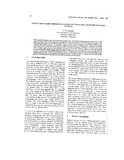| dc.contributor.author | Ganesan, C.T. | |
| dc.date.accessioned | 2010-10-19T15:37:27Z | |
| dc.date.available | 2010-10-19T15:37:27Z | |
| dc.date.issued | 1999 | |
| dc.identifier.citation | Ganesan, C.T. (1999) Low flush water closets in buildings and their effects in the drainage systems, Botswana Journal of Technology, Vol.8,No.1,pp.38-43 | en_US |
| dc.identifier.issn | 1019 1593 | |
| dc.identifier.uri | http://hdl.handle.net/10311/618 | |
| dc.description.abstract | Water scarcity in arid and semi-arid countries such as Botswana; call for judicious planning and economic use. In this connection many water saving components and appliances have been devised. One such system for example is the partial flushing unit fitted to water closets, which cause the volume and flow of water in the drainage system decrease, compared with the ordinary systems. To maintain a sufficient transportation in drainage pipes connected to low flush water closets (water closets with a flow less than 6 litres per flush)it is necessary to follow a set of rules used in conventional systems. Author suggests that in countries like Botswana where availability of water is unpredictable only 4 litres per flush can be allowed for successful operations. In this paper certain rules for design and dimensioning drainage pipes for water saving systems are proposed. Besides the paper presents a complete general survey of the influence of branches and bends illustrated by means of drawings and descriptions. | en_US |
| dc.language.iso | en | en_US |
| dc.publisher | University of Botswana | en_US |
| dc.subject | Low flush water closets | en_US |
| dc.subject | Buildings | en_US |
| dc.subject | Drainage systems | en_US |
| dc.subject | Botswana | en_US |
| dc.title | Low flush water closets in buildings and their effects in the drainage systems | en_US |
| dc.type | Published Article | en_US |

